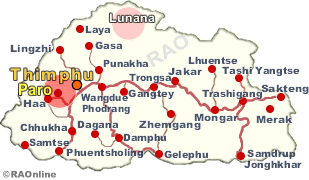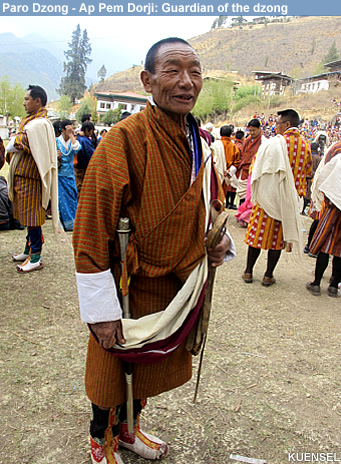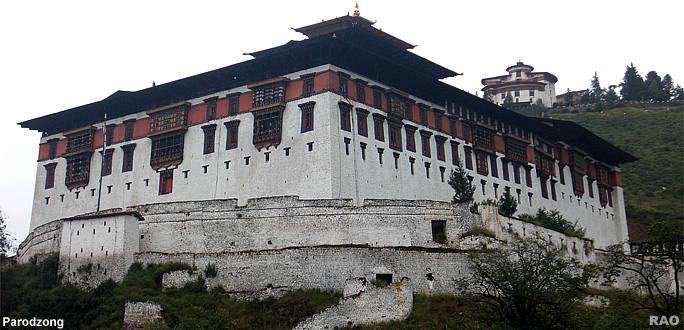 |
Bhutan's Culture Dzongs |
|
 |
Bhutan Information |
|
|
 |
| Guardian of the dzong |
 |
 |
|
Paro Tshechu: Amongst the thousands attending the Paro tshechu is soft-spoken Pem Dorji, who wears a smile on his weathered face.
He is neither a gup nor a senior government official, yet he wears the gup's kabney, and dangles a patang (sword) from the right side of his waist.In his hand he holds a whip made of cowhide. |
|
 |
|
A few call him Dasho Khangnyerp, a title originating from the time of Zhabdrung Ngawang Namgyal.Khangnyerliterally means watchman appointed for guarding dzongs.
The legacy of khangnyer still prevails in Paro dzong, and he demonstrates his role during the annual tshechu.
Had he been in the civil service, Pem would have retired, but the 67-year-old is still serving the dzongkhag ever since his appointment in 1996.As a khangnyer, he has been controlling the crowd for the past 16 years.These days, he helps manage the crowd, together with the police.
But he senses that his watchman days may be over. "My role is on the verge of ending," he said laughing. "I no longer have to look after the crowd, as much as I did in those days."Today, he coordinates the preparatory work, especially during tshechu, and informs mask dancers about meal times.
Former Paro dzongda Lam Rinzin, 85, explained that, during the time of Zhabdrung, khangnyers served as the gatekeeper of the Dzong.
|
|
They made calls before dark, alerting people to put off the lights. "If lighting wasn't cared for, it could endanger the dzong," Lam Rinzin said.
The khangnyer lived in a small house attached to the main gate of the Dzong. "Those days khangnyer was so powerful that all gups of Bakor Tsoduk, in present day 10 gewogs of the dzongkhag, had to listen and abide by his order," Lam Rinzin said. "He supervised and controlled them."
Many said that khangnyers were so powerful that they used the whip on people, who did not listen. Goenpo, 53, remembers one of the khangnyers beating him during a tshechu. "I can vividly recollect a watchman raising hands on me when I was a child," he said.Dzongkhag culture officer Karma Dorji also recollectskhangnyers beating people. "Khangyners were powerful," he said.
Khangyer Pem Dorji said that he might have beaten more than 1,000 people in the line of duty. "I beat those, who were undisciplined and disturbing public occasions."According to him, people held the post of khangnyer only after serving many years in the dzong.But he was a soldier before assuming the post.
Pem Dorji says the patang represents his role in the civil administration, and the four-foot long whip indicates his service to the clergy.
As part of his service to the clergy, he would collect religious items for performing major rituals.But the most difficult task was collecting donkey's urine. "We had to wait for long hours, as the donkey wouldn't urinate in our presence," he said.
The urine was required when wrathful ceremonieswere performed.Even today, he acts as a messenger between administration and rabdey.He also assists caretakers of the lhakhangs in collecting water for morning choep (water offering)
On the administration part, he supervises elementary service personnel, who work to maintain cleanliness in and around the dzong premises.
Standing in one corner, Pem keeps a close watch over spectators, the whip in his left hand.During the morning chirdrel procession, he is in the front line, leading the group; and in the evening, he stands among dancers and participants to listen to the briefings and plans by a senior government official.
The father of five from Changnangkhar has only two days to showcase his role with patang and whip.When the tshechu's over on Friday, he has to hang them up and resume his daily work in the dzong. "I feel proud when I put on the sword," he said. "It's the sign of a hero."
 |
| Contributed by
Kuensel, Bhutan's National Newspaper |
top
| more
information |
 |
|





